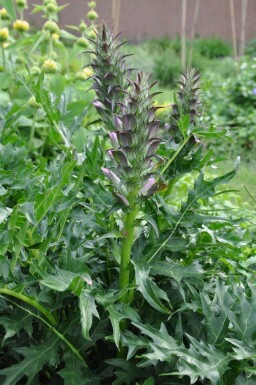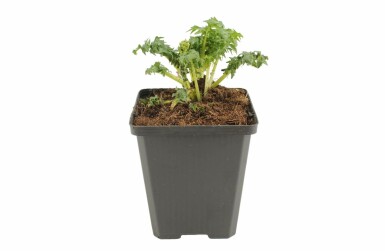

125cm




Welcome to the majestic world of Acanthus, a genus celebrated for its striking foliage and elegant flower spikes that grace gardens with hues of purple, pink, and white. The Acanthus plant, with its deep green leaves, stands as a testament to classical beauty and has been an inspiration in art and architecture for centuries. This herbaceous perennial may not be evergreen or fragrant, but its commanding presence and intricate leaf design make it a focal point in any garden composition. Whether adorning a border or serving as a standalone feature, the Acanthus is a true horticultural treasure.


125cm






100cm




The Acanthus genus, renowned for its bold and architectural foliage, has been an emblem of artistic inspiration since ancient times. Its deeply lobed leaves and towering flower spikes have graced everything from Corinthian columns to intricate textiles. Thriving in both sun and partial shade, Acanthus plants boast an impressive display of purple, pink, and white blossoms through the warmest months, from May to September. Their upright to bushy growth habit creates a striking presence in any garden setting, whether used as a border, grouped for impact, or standing alone in solitary splendor.
Acanthus plants are perfect for gardeners seeking to add a touch of classical elegance to their landscapes. Key features of this genus include:
To ensure your Acanthus plants thrive, consider these gardening tips:
By incorporating these practices into your gardening routine, you can enjoy the regal beauty of Acanthus in your garden for years to come.
Embrace the grandeur of antiquity with the Acanthus, an emblem of classical elegance and enduring beauty. Revered in garden design for their bold, sculptural leaves and towering flower spikes, these plants are a statement of refined taste and a testament to timeless appeal. Ideal for adding a touch of architectural drama to your garden, the Acanthus thrives, bringing with it a sense of history and sophistication.
We would like to provide some tips on how to plant and care for a Acanthus. By following these tips, you can be sure to enjoy your Acanthus for a long time.
For optimal growth, this species flourishes in a location where it can bask in the full sun or enjoy the dappled light of partial shade. The soil should cater to its preference for well-drained conditions, regardless of the soil type. Ensuring that the soil facilitates proper drainage will help maintain the plant's health and support its striking floral display from spring through summer. The plant's versatility allows it to adapt to various soil compositions, provided that moisture can adequately percolate to accommodate its average water needs without becoming waterlogged.
This species thrives in a variety of well-drained soils and can be positioned in either full sun or partial shade. When planting, ensure there is ample space to accommodate its upright to bushy growth habit. The planting hole should be as deep as the root ball and twice as wide. Carefully remove the plant from its container, loosen the roots gently, and place it in the hole. Fill with soil, firming it down lightly, and water thoroughly to settle the roots. Regular watering is necessary for the plant to establish itself, although it exhibits drought resistance once mature.
For optimal growth and a vibrant display of blooms, it is recommended to fertilize Acanthus species at the onset of the growing season. A balanced, slow-release fertilizer applied once in early spring will provide the necessary nutrients for the species to thrive. This approach ensures a steady supply of nutrients during the peak growing and flowering months, from May through September.
Care should be taken to evenly distribute the fertilizer around the base of the plant, avoiding direct contact with the foliage to prevent potential burn. Acanthus plants, with their robust nature and drought resistance, will benefit from this nourishment, leading to lush, green foliage and an abundance of flowers in shades of purple, pink, and white. A second light application of fertilizer can be made in mid-summer to support prolonged flowering into the autumn season.
Pruning is not essential for the Acanthus but can be beneficial for aesthetic purposes and to promote healthy growth. After flowering, to encourage a second bloom, remove the spent flower spikes. This will help to maintain an attractive appearance and stimulate the plant's energy back into foliage and root development. In late autumn or early winter, as the plant dies back, you can cut the foliage to ground level. This tidies the plant and prepares it for the next growing season, ensuring a robust display of its striking foliage and blooms.
The Acanthus requires consistent moisture to thrive, particularly during its blooming period from spring through summer. While the species is equipped to handle temporary dry spells thanks to its drought resistance, it is essential to provide it with an average amount of water to support its lush, upright to bushy growth habit. Watering should ensure a well-drained environment to prevent any potential waterlogging, which could be detrimental to the plant's health. During extended periods of high heat or drought, additional irrigation may be necessary to maintain the vitality of the foliage and the vibrancy of its purple, pink, or white blooms.
This species, known for its impressive foliage and towering flower spikes, is a delightful addition to any garden. It thrives in a pot, allowing for flexibility in placement and the opportunity to create a focal point on patios or in courtyards. The leaves of Acanthus often inspire artists and have historically influenced architectural designs, making this plant not only a garden favorite but also a symbol of enduring beauty in decorative arts.
To propagate the Acanthus effectively and maintain its health, division should be carried out in the cooler months of spring or autumn. By gently removing the plant from the soil, one can identify sections with vigorous growth for replanting. Each division should have a portion of the root system to ensure successful reestablishment. Replant the divisions promptly in well-drained soil, spacing them adequately to accommodate their upright to bushy growth habit. This method stimulates new growth and rejuvenates the plant, ensuring a robust display of purple, pink, and white blooms in the flowering season.
Embrace the classical elegance of Acanthus, a majestic plant renowned for its striking, deeply lobed leaves and towering flower spikes. Perfect for adding architectural interest to any garden, this noble species thrives with minimal care, making it an exquisite yet effortless addition to your outdoor space.
